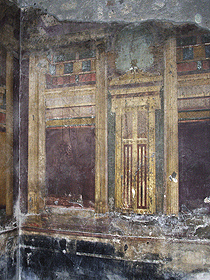 1>
1>False-Doors and Related Signifiers
Villa dei Misteri and Villa di Poppea (Oplontis) contain several examples of pictorial door motifs that appear to function in a similar way to false-door imagery in Egyptian iconography and in so doing they support Picard's proposition that the door motif was an indexical-symbolic image designed to evoke a transition between physical and metaphysical worlds. The paintings in these villas also give us an insight into the various ways in which the entrance motif was adapted in order to function in public and private spaces. The door image on the end wall of the oecus (room 6) of the rustic Villa dei Misteri, located on the outskirts of Pompeii, has all the formal characteristics associated with the public display of lineage and the honouring of the gods (fig.1). It is depicted in an honorary raised position similar to temple doors and the lateral walls contain depictions of sacrificial garlands similar to those found in tombs and on the sides of sarcophagi.
In contrast, the false-door imagery in room 16 is located in a private environment, a cubiculum or bedroom. The room consists of two alcoves in which beds were once located. The two lateral walls of the alcove opposite the entrance contain depictions of ivory and tortoiseshell doors, above which can be seen the tops of shrines, thus indicating that the doors are entrances to sanctuaries (fig.2). The adjacent alcove also makes reference to a tholos sanctuary (fig.3). Columns, perpendicular architraves and a broken pediment infer the presence of an entrance, which is denied by the presence of a high wall. A dropped curtain above the wall reinforces the theme of a barrier beyond which can be seen the tholos containing a statue. Compositions such as these suggest that the bedroom’s occupants may have used these paintings as psychological triggers that enabled them to commune with, or seek protection from, gods and departed ancestor spirits.
Several of the rooms in the Villa di Poppea, located between Pompeii and Herculaneum, also display false-door imagery denoting public and private communion with metaphysical worlds. The villa also contains several generic false-door adaptations, in which various entrance motifs are used as eschatological symbols. The great atrium (room 5) contains a quintessentially Roman false-door adaptation consisting of 4 honorific doors, two on either side of the lateral walls (fig.4). All four of the ivory and tortoiseshell encrusted doors have sacrificial or funerary imagery on the steps leading up to them and winged Victories depicted on the upper sections of the doors. Those on the west wall are the most visible and the door furthest away from the entrance has an upward facing flaming torch placed on its steps, which normally symbolises the burial procession as opposed to the downward facing extinguished torch symbolising death. This connotation is reinforced by the frieze above the door depicting a street of tombs, similar to those lining the roads into cities such as Pompeii and Herculaneum (fig.5).The west and east walls of this palatial atrium mirror each other and only vary in terms of sacred and apotropaic images such as thymiaterion (incense burners) and cista mistica (ornate containers associated with sacred rituals).
|